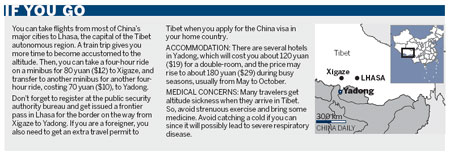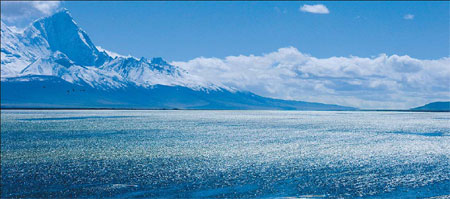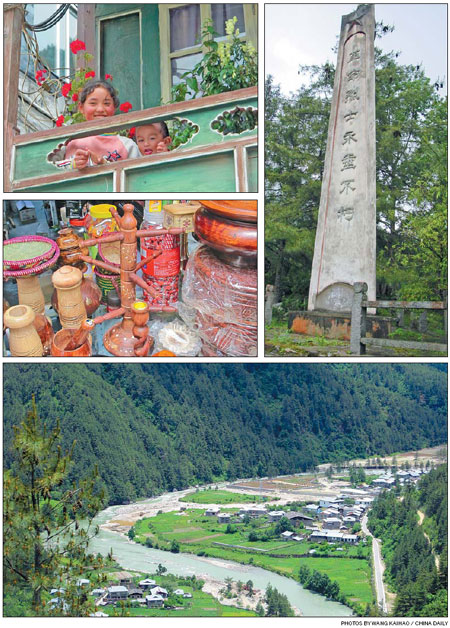Tips and Articles
Get off your high horse
Updated: 2011-08-11 07:49
By Wang Kaihao (China Daily)
|
Snow-capped peaks and crystal clear lakes in Yadong county, southermost part of the Tibet autonomous region. Provided to China Daily |
|
Clockwise from above: Xiasima town, nestled at the bottom of a green valley, with the Yadong River running through. Indian goods on sale in Renqinggang, the only frontier market on the China-India border. Two kids in Xiasima greet visitors from the balcony of their house. A monument in Yadong erected in honor of the Chinese soldiers who fought in the China-India war of 1962. Photos by Wang Kaihao / China Daily |

And enjoy Yadong in Tibet autonomous region, a picturesque county that is dwarfed by the mighty Mount Chomolhari. Wang Kaihao reports.
The landscape changes dramatically as the altitude drops from 3,840 meters above sea level to 2,900 meters, along the road from Xigaze to Yadong, in Tibet autonomous region.
Instead of barren and craggy scenes, babbling streams and trees make their appearance as the road snakes through the mountains toward Yadong, in southernmost Tibet.
By the time I arrive I have begun to shake off the cold, nausea and headache caused by altitude sickness and I'm starting to enjoy the summer weather.
The stream finally becomes a 30-meter-wide river as I descend into the valley. Rapeseed flowers in full bloom spread over the fields, interspersed with rows of red-roofed cabins.
The county seat of Yadong is called Xiasima, which means "even an important official has to get off his horse here". It has a casual and simple charm.
There's only one street and just 3,000 residents, mostly Tibetans. Yadong River separates the town into two parts, connected by a stone bridge. Two-to-three-floor houses made of stone and wood line the street.
Though small, the town has all the usual amenities, including an Internet cafe and Xinhua bookstore.
In summer, even at 8 pm, the sun is still shining and vendors push their handcarts loaded with tea, medicinal herbs and handicrafts, through the street.
I stop to take pictures of the hand-made dcor over the doors and windows, say hello to locals leaning on balconies and enter a teahouse to enjoy a cup of butter tea.
As for cuisine there is Sichuan or Yunnan food, since several restaurants are run by people from these two provinces.
Highly recommended is Yadong fish. Though Yadong River flows into the Ganges River, in India, it's said Yadong fish won't cross the border because they're used to the temperature and altitude. Locals call it the "patriotic fish".
Yadong is famed for its wild jelly ear fungus, which comes from the primitive forest. It's very nutritious and a kilogram of the dried fungus costs about 4,000 yuan ($623).
With a dish of steamed Yadong fish, a plate of fried jelly ear fungus and goblets of highland barley wine, a traditional drink in Tibet, time with friends is well spent.
Yadong borders Sikkim state of India on its western side and Bhutan on its east. In 1902, Britain occupied Xiasima and launched its two-year invasion of Tibet. In 1962, China and India fought a battle here due to a border dispute.
There are two monuments memorializing those who fought and died in the conflicts.
Today, instead of war there is trade and Yadong is a meeting place for merchants from all over China, India, Nepal and Bhutan.
All the stores in Xiasima have bilingual signs, both in Mandarin and Tibetan. Herbal medicines like caterpillar fungus and snow lotus are among their most popular products.
A one-hour ride up a mountainous road is Renqinggang, the only frontier market on the China-India border, selling miscellaneous Indian and Nepalese goods, such as cigarettes, tapestry and blankets.
Do bargain: You can get a delicate shawl made of pashmina, a kind of fine cashmere wool, for just 25 yuan ($4), for example.
Finally, you should also take some time to appreciate the gargantuan beauty of misty Mount Chomolhari, topped by glittering snow, set against an azure sky backdrop.
This peak, 7,350 meters above sea level, is sacred to Tibetan Buddhists and known as the "fairy woman". According to local folklore, Chomolhari is the bride of Kanchenjunga, the world's third highest mountain, in India's Sikkim state. Sadly, the couple can only see each other from a distance.

Specials

Star journalist leaves legacy
Li Xing, China Daily's assistant editor-in-chief and veteran columnist, died of a cerebral hemorrhage on Aug 7 in Washington DC, US.

Beer we go
Early numbers not so robust for Beijing's first international beer festival

Lifting the veil
Beijing's Palace Museum, also known as the Forbidden City, is steeped in history, dreams and tears, which are perfectly reflected in design.

